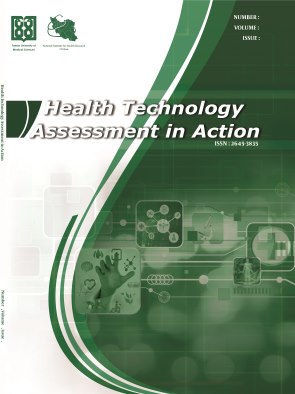An Observational Study on Evaluation of IOTA Ultrasound Simple Rules to Distinguish Benign and Malignant Ovarian Masses and Histopathological Correlation in a Tertiary Care Hospital
Abstract
Background: The international ovarian tumor analysis (IOTA) study technique is a specialized method for classifying and identifying adnexal growths. It employs 10 simple ultrasound directions to characterize masses as benign or malignant.
Objectives: This study aims to provide pre-operative information to help gynecologists manage ovarian masses, avoiding delays in malignancy treatment and unnecessary surgery for benign lesions.
Methods: This was a hospital-based observational study conducted in the radiology department on patients with clinical diagnoses of ovarian masses from August 2020 to March 2022 by prospective randomized sampling method. Patients with suspected ovarian pathology were evaluated using IOTA ultrasound rules and designated benign or malignant. The patients underwent a thorough history and clinical examination. Ultrasound was used to confirm the ovarian origin of the mass and differentiate it as benign or malignant. A transvaginal ultrasound was performed where necessary. Histopathological examination was the gold standard to confirm ultrasound and Doppler findings. Descriptive stats: Frequencies/percentages for categorical data, mean ± SD for normal, median with IQR for non-normal Uncertainty measured by 95% CI.
Results: During the study, 50 women were eligible for the study, and the mean age of the participants was 45.3 years. Of 50 patients who underwent surgery, 38 cases were considered benign based on IOTA USG rules, of which 35 were benign and 3 were malignant histologically Eight cases were considered malignant based on IOTA USG rules, of which 6 were malignant and 2 were benign. Four cases were considered indeterminate, with two being benign and two being malignant histologically. If inconclusive cases are classified as malignant, the sensitivity and specificity are 75% and 88%, respectively.
Conclusions: USG is an easily available imaging tool that can be used as an initial modality in evaluating ovarian masses. IOTA simple ultrasound rules have diagnostic accuracy in distinguishing benign and malignant ovarian masses and help in management.
2. Verkauf BS, Bernhisel M. Ovarian maldescent. FertilSteril.1996; 65:189– 192.
3. Timmerman D, Testa AC, Bourne T, et al. Logistic regression model to distinguish between the benign and malignant adnexal mass before surgery: a multicenter study by the International Ovarian Tumor Analysis Group. J Clin Oncol 2005;23:8794-801.
4. Timmerman D, Testa AC, Bourne T, et al. Simple ultrasound-based rules for the diagnosis of ovarian cancer. Ultrasound ObstetGynecol. 2008;31:681-90.
5. Kaijser J, Bourne T, Valentin L, et al. Improving strategies for diagnosing ovarian cancer: a summary of the International Ovarian Tumor Analysis (IOTA) studies. Ultrasound ObstetGynecol.2013;41:9-20.
6. Fathallah K, Huchon C, Bats AS, et al. Validation externe des critères de Timmerman surunesérie de 122 tumeursovariennes. GynecolObstetFertil.2011;39:477-81.
7. Hartman CA, Juliato CRT, Sarian LO, et al. Ultrasound criteria and CA 125 as predictive variables of ovarian cancer in women with adnexal tumors. Ultrasound ObstetGynecol.2012;40:360-6.
8. Alcázar JL, Pascual MÁ, Olartecoechea B, et al. IOTA simple rules for discriminating between benign and malignant adnexal masses: prospective external validation. Ultrasound ObstetGynecol.2013;42:467-71.
9. Sayasneh A, Wynants L, Preisler J, et al. Multicenter external validation of IOTA prediction models and RMI by operators with varied training. Br J Cancer .2013;108:2448-54.
10. Tantipalakorn C, Wanapirak C, Khunamornpong S, Sukpan K, Tongsong T. IOTA simple rules in differentiating between benign and malignant ovarian tumors. Asian Pac J Cancer Prev.2014;15:5123-6.
11. Nunes N, Ambler G, Foo X, Naftalin J, Widschwendter M, Jurkovic D. Use of IOTA simple rules for diagnosis of ovarian cancer: a meta-analysis. Ultrasound ObstetGynecol.2014;44:503-14.
12. Tinnangwattana D, Vichak-ururote L, Tontivuthikul P, Charoenratana C, Lerthiranwong T, Tongsong T. IOTA simple rules in differentiating between benign and malignant adnexal masses by non-expert examiners. Asian Pac J Cancer Prev.2015;16:3835-8.
13. Ruiz de Gauna B, Rodriguez D, Olartecoechea B, et al. Diagnostic performance of IOTA simple rules for adnexal masses classification: a comparison between two centers with different ovarian cancer prevalence. Eur J ObstetGynecolReprodBiol. 2015;191:10-4.
14. Knafel A, Banas T, Nocun A, Wiechec M, Jach R, Ludwin A, Kabzinska-Turek M, Pietrus M, Pitynski K. The Prospective External Validation of International Ovarian Tumor Analysis (IOTA) Simple Rules in the Hands of Level I and II Examiners. Ultraschall Med. 2016; 37(5):516-523.
15. Meinhold-Heerlein I, Fotopoulou C, Harter P, Kurzeder C, Mustea A, Wimberger P, Hauptmann S, Sehouli J. The new WHO classification of ovarian, fallopian tube, and primary peritoneal cancer and its clinical implications. Arch Gynecol Obstet. 2016 ;293(4):695-700.
16. Royal College of Obstetricians and Gynecologists, British Society of Gynecological Endoscopy. Management of suspected ovarian masses in premenopausal women. Green Top guidelines 62, 2011. Available at: https://www. rcog.org.uk/en/guidelines-research-services/ guidelines/gtg62/. Accessed November 2, 2015.
17. Woo YL, Kyrgiou M, Bryant A, Everett T, Dickinson H. Centralization of services for gynecologicalcancersea Cochrane systematic review. GynecolOncol.2012;126:286-90.
18. Engelen MJA, Kos HE, Willemse PHB, et al. Surgery by consultant gynecologiconcologistsimproves survival in patients with ovarian carcinoma. Cancer .2006;106:589-98.
19. Vernooij F, Heintz APM, Witteveen PO, et al. Specialized care and survival of ovarian cancer patients in The Netherlands: nationwide cohort study. J Natl Cancer Inst.2008;100: 399-406.
20. Earle CC, Schrag D, Neville BA, et al. Effect of surgeon specialty on processes of care and outcomes for ovarian cancer patients. J Natl Cancer Inst.2006;98:172-80.
21. Fathallah K, Huchon C, Bats AS, et al. Validation externe des critères de Timmerman surunesérie de 122 tumeursovariennes. GynecolObstetFertil.2011;39:477-81.
22. Sayasneh A, Kaijser J, Preisler J, et al. A multicenter prospective external validation of the diagnostic performance of IOTA simple descriptors and rules to characterize ovarian masses. GynecolOncol.2013;130:140-6.
23. Garg S, Kaur A, Mohi JK, Sibia PK, Kaur N. Evaluation of IOTA Simple Ultrasound Rules to Distinguish Benign and Malignant Ovarian Tumours. J ClinDiagn Res. 2017 ;11(8): TC06-TC09.
| Files | ||
| Issue | Vol 7, No 3 (2023) | |
| Section | Articles | |
| DOI | https://doi.org/10.18502/htaa.v7i3.14211 | |
| Keywords | ||
| IOTA USG rules International Ovarian Tumour Analysis Ovarian cancers | ||
| Rights and permissions | |

|
This work is licensed under a Creative Commons Attribution-NonCommercial 4.0 International License. |




